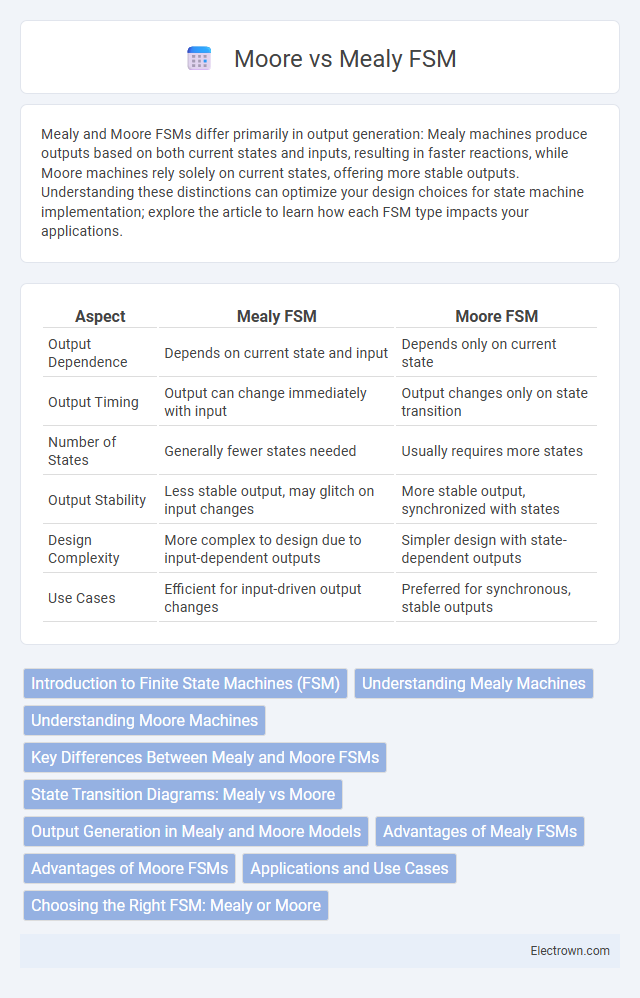Mealy and Moore FSMs differ primarily in output generation: Mealy machines produce outputs based on both current states and inputs, resulting in faster reactions, while Moore machines rely solely on current states, offering more stable outputs. Understanding these distinctions can optimize your design choices for state machine implementation; explore the article to learn how each FSM type impacts your applications.
Table of Comparison
| Aspect | Mealy FSM | Moore FSM |
|---|---|---|
| Output Dependence | Depends on current state and input | Depends only on current state |
| Output Timing | Output can change immediately with input | Output changes only on state transition |
| Number of States | Generally fewer states needed | Usually requires more states |
| Output Stability | Less stable output, may glitch on input changes | More stable output, synchronized with states |
| Design Complexity | More complex to design due to input-dependent outputs | Simpler design with state-dependent outputs |
| Use Cases | Efficient for input-driven output changes | Preferred for synchronous, stable outputs |
Introduction to Finite State Machines (FSM)
Finite State Machines (FSM) are computational models used to design digital logic and control systems, defined by a finite number of states, transitions, and outputs. Mealy FSMs generate outputs based on the current state and input, resulting in faster responses, while Moore FSMs rely solely on the current state to determine outputs, offering more stable and predictable behavior. Understanding these fundamental differences helps you select the appropriate FSM model for efficient system design and implementation.
Understanding Mealy Machines
Mealy machines generate outputs based on both the current state and input signals, enabling faster response to inputs compared to Moore machines, which produce outputs solely dependent on the current state. This characteristic allows Mealy FSMs to have fewer states and more efficient state transitions, optimizing hardware resources in digital circuit design. Understanding the behavior of Mealy machines is crucial for applications requiring immediate output changes, such as asynchronous control systems and real-time encoding.
Understanding Moore Machines
Moore machines produce outputs solely based on their current states, making their behavior easier to analyze and design compared to Mealy machines, which generate outputs dependent on both states and inputs. This characteristic leads to more predictable timing and simpler state diagrams in Moore FSMs, crucial for synchronous circuit design. The output changes occur only at state transitions, providing stable and glitch-free signals beneficial in hardware implementations.
Key Differences Between Mealy and Moore FSMs
Mealy FSM outputs depend on both the current state and input signals, enabling faster response to input changes, while Moore FSM outputs rely solely on the current state, resulting in more stable and predictable outputs. You will find Mealy machines typically require fewer states, which can simplify the design but may introduce output glitches, whereas Moore machines, with their state-dependent outputs, tend to produce cleaner output signals. Understanding these key differences helps optimize finite state machine design based on timing requirements and output reliability.
State Transition Diagrams: Mealy vs Moore
Mealy and Moore FSMs differ significantly in their state transition diagrams: Mealy machines produce outputs based on both the current state and input, resulting in transitions labeled with input/output pairs, while Moore machines generate outputs solely from the current state, leading to state-labeled outputs independent of inputs. Your design choice impacts timing and complexity, as Mealy FSMs often have fewer states but require more complex transitions, whereas Moore FSMs offer simpler state-based outputs and easier debugging. Understanding these distinctions in state transition diagrams is crucial for optimizing your finite state machine implementation.
Output Generation in Mealy and Moore Models
Mealy finite state machines generate outputs based on the current state and input signals, enabling faster response times since output changes immediately with input variations. Moore finite state machines produce outputs solely from the current state, resulting in outputs that change only at state transitions, which simplifies timing analysis and reduces output glitches. The choice between Mealy and Moore models impacts system latency and complexity, with Mealy offering reduced latency and Moore providing more stable output behavior.
Advantages of Mealy FSMs
Mealy FSMs offer faster output response since outputs depend on both current states and inputs, enabling immediate reaction to input changes without waiting for state transitions. This results in more efficient hardware utilization, often requiring fewer states compared to Moore machines, which simplifies state diagram complexity. Mealy FSMs are particularly advantageous in digital control applications where rapid output updates directly linked to inputs are critical.
Advantages of Moore FSMs
Moore FSMs offer advantages such as simpler and more predictable output behavior because outputs depend solely on states, reducing glitches and timing hazards. Their design facilitates easier debugging and verification due to stable outputs that change only on state transitions. These characteristics make Moore FSMs beneficial for applications where consistent output timing and reliability are critical for Your system's integrity.
Applications and Use Cases
Mealy finite state machines (FSMs) are often employed in applications requiring faster output response since their outputs depend on both states and inputs, making them ideal for control circuits and communication protocols. Moore FSMs are preferred in designs demanding stable and glitch-free outputs due to their state-dependent output generation, commonly used in digital systems like sequence detectors and synchronous circuits. Both FSM types find widespread use in embedded systems, but the choice hinges on output timing requirements and complexity of input-output relationships.
Choosing the Right FSM: Mealy or Moore
Choosing the right FSM between Mealy and Moore depends on your design requirements for output timing and complexity. Mealy machines generally offer faster output response since their outputs depend on both the current state and input, making them ideal for applications needing prompt reactions. Moore machines produce outputs solely based on the current state, resulting in simpler state encoding and more stable outputs, which benefits your design when predictability and simplicity are priorities.
Mealy vs Moore FSM Infographic

 electrown.com
electrown.com